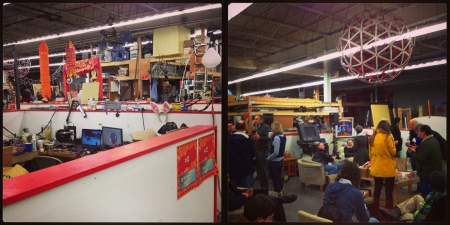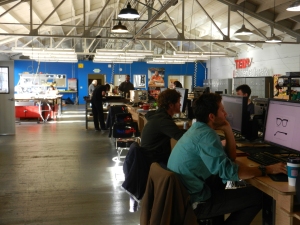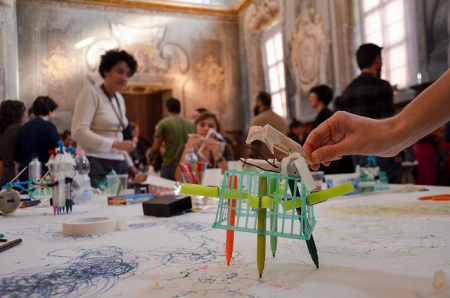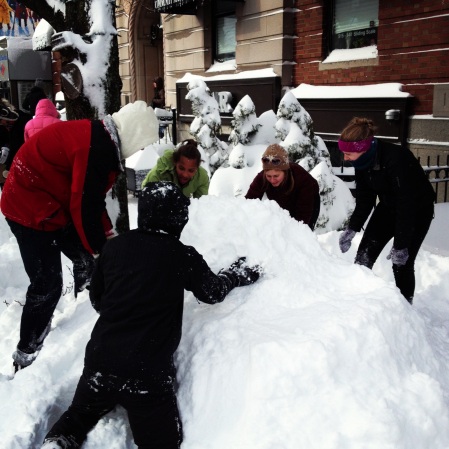
Artisan’s Asylum, a 40,000 square foot makerspace in Somerville, MA offers its members individual studio spaces, access to a variety of workshops, and a centrally located social space to both share ideas—and hang out.
Taking cues from the burgeoning field of “maker,” the Agency by Design team is investigating work at the cross-roads of the maker movement, tinkering, design thinking, and education. From the DARPA funding of school-based maker spaces to the growing popularity of robotics competitions, educational interest in these spheres has been exploding. But so, too, has interest from the business, non-profit, and even social networking sector. While our research team is learning about the teaching and learning side of maker with the Temescal Learning Community in Oakland, we also are curious about what’s happening on a conceptual level. To do this, we have begun to conduct site visits and talk to folks working in these fields: at fab-labs, makerspaces, schools, businesses, and not-for-profit organizations.
Based on our initial research, there seem to be three concurrent strands driving—or perhaps responding to—the resurgence in the DIY/maker mentality: “I want to do it,” “I can do it,” and “let’s do it together.”
I want to do it
Whether knitting a sweater, tinkering with a broken clock, or hacking a computer program, a maker mentality starts with a desire to do it yourself. Though it may be easier—and perhaps cheaper—to go to the Gap, visit a clockmaker, or hire a recent computer science grad to do the work for you, there’s something satisfying about making. It’s hard to say what’s driving this desire to make, fix, or tinker. (In fact, as AbD develops interview protocols and begins more formal data collection, this will certainly be an area of inquiry for us.) One theory is that it’s a reaction to big box stores, production chains, and corporate influence—a way to feel connected to an object, to see one’s hand in the work, to identify and engage with unique products. Or perhaps it’s an attempt to better understand how things are made—and how they work. After all, we engage on a daily basis with objects and systems that may feel quite distant—systems we may not understand, nor need to understand (um, iPhone?).
I can do it
Of course for many, the want can only be realized if accompanied by a sense of capability. Fortunately, this has been answered in part by 24-7 access to DIY resources, such as how-to sites and online manuals, as well as a growing network of online forums and collaborators. From remixing music to fixing the crack in a plumbing pipe, more and more people (young and old) are engaging their hands in daily life. They are doing it—whatever “it” is—themselves. Wanting to make, and being able to, inspires not only a sense of accomplishment, but a feeling of empowerment. Offering opportunities for people to engage in making, to solve their own problems or answer their own questions, allows for those a-ha moments of “I can do that.”
Let’s do it together

Tech Shop provides its users with a space to access a variety of tools, technology, and other resources.
Yet an ability to do it yourself can be limited by experience, knowledge, and access to tools and space. Enter the shared economy. Want to build a bookshelf but don’t have the tools or the knowledge? Makerspaces—where you’ll find access to shared tools, introductory classes, even studio space for exploration and storage—are popping up all over the country. And they’re not limited to traditional wood and metal work. Sewing and textile spaces, hackerspaces, fablabs, and even social networking opportunities like hacker/maker meet-ups are all part of this culture of shared maker experiences.
Continue reading →





